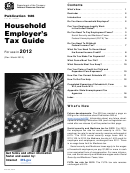Publication 80 - Federal Tax Guide (Circular Ss) - Internal Revenue Service - 2012 Page 7
ADVERTISEMENT
Sick pay. In general, sick pay is any amount that you pay,
return. If deposits are underpaid, see
Deposit Penalties
in
under a plan that you take part in, to an employee because
section 8.
of sickness or injury. These amounts are sometimes paid
Valuation of vehicles provided to employees. If you
by a third party, such as an insurance company. In either
provide a vehicle to your employees, you may either deter-
case, these payments are subject to social security, Medi-
mine the actual value of the benefit for the entire calendar
care, and FUTA taxes (U.S. Virgin Islands only). Sick pay
year, taking into account the business use of the vehicle, or
becomes exempt from these taxes after the end of 6
consider the entire use for the calendar year as personal
calendar months after the calendar month the employee
and include 100% of the value of the vehicle in the em-
last worked for the employer. Publication 15-A explains the
ployee’s income. For reporting information to employees,
employment tax rules that apply to sick pay, disability
see the box 14 instructions under Specific Instructions for
benefits, and similar payments to employees.
Forms W-2AS, W-2GU, and W-2VI in the separate Instruc-
tions for Forms W-2AS, W-2GU, W-2VI, and Form W-3SS.
Fringe Benefits
Special accounting rule for fringe benefits provided
during November and December. You may choose to
Generally, fringe benefits are includible in the gross in-
treat the value of taxable noncash fringe benefits provided
come of an employee and are subject to employment
during November and December as paid in the next year.
taxes. Examples of fringe benefits include the use of an
However, this applies only to those benefits that you actu-
automobile, aircraft flights that you provide, free or dis-
ally provided during November and December, not to
counted commercial airline flights, vacations, discounts on
those you merely treated as paid during those months.
property or services, memberships in country clubs or
If you use this rule, you must notify each affected em-
other social clubs, and tickets to entertainment or sporting
ployee between the time of the employee’s last paycheck
events. In general, the amount included in the employee’s
of the calendar year and at or near the time that you give
income is the excess of the fair market value of the benefit
the employee Form W-2AS, W-2CM, W-2GU, or Form
over the sum of any amount paid for it by the employee and
W-2VI. If you use the special accounting rule, your em-
any amount excluded by law. For more information, see
ployee must also use it for the same period that you use it.
Publication 15-B, Employer’s Tax Guide to Fringe Bene-
You cannot use this rule for a fringe benefit of real property
fits.
or tangible or intangible real property of a kind normally
When fringe benefits are treated as paid. You can
held for investment that is transferred to your employee.
choose to treat certain noncash fringe benefits (including
personal use of an automobile provided by you) as paid by
5. Tips
the pay period, quarter, or on any other basis that you
choose, but they must be treated as paid at least annually.
You do not have to make a formal choice of payment dates
Tips that your employee receives from customers are
or notify the IRS. You do not have to use the same basis for
generally subject to social security and Medicare withhold-
all employees. You may change methods as often as you
ing. Your employee must report cash tips to you by the
like, as long as all benefits provided in a calendar year are
10th of the month after the month that the tips are received.
treated as paid no later than December 31 of the calendar
The report should include tips you paid over to the em-
year. However, see
Special accounting rule for fringe ben-
ployee for charge customers, tips the employee received
efits provided during November and
December, later in this
directly from customers, and tips received from other em-
section.
ployees under any tip-sharing arrangement. Both directly
You can treat the value of a single taxable noncash
and indirectly tipped employees must report tips to you.
fringe benefit as paid on one or more dates in the same
The report should not include tips that the employee paid
calendar year, even if the employee gets the entire benefit
out to other employees. No report is required for months
at one time. However, once you elect the payment dates,
when tips are less than $20. Your employees report tips on
you must report the taxes on your return in the same tax
Form 4070, Employee’s Report of Tips to Employer, or on
period in which you treated them as paid. This election
a similar statement. They may also use Form 4070A,
does not apply to a fringe benefit where real property or
Employee’s Daily Record of Tips, to keep a record of their
investment personal property is transferred.
tips. Both forms are printed in Publication 1244, Em-
ployee’s Daily Record of Tips and Report to Employer,
Withholding social security and Medicare taxes on
available at IRS.gov.
fringe benefits. You add the value of fringe benefits to
The statement must be signed by the employee and
regular wages for a payroll period and figure social security
must include:
and Medicare taxes on the total.
•
The employee’s name, address, and SSN,
If you withhold less than the required amount of social
security and Medicare taxes from the employee in a calen-
•
Your name and address,
dar year but report and pay the proper amount, you may
•
The month or period that the report covers, and
recover the taxes from the employee.
•
The total tips received during the month or period.
Depositing taxes on fringe benefits. Once you choose
payment dates for taxable noncash fringe benefits, you
Collecting taxes on tips. You must collect the employee
must deposit taxes in the same deposit period that you
treat the fringe benefits as paid. You may make a reasona-
social security and Medicare taxes on the employee’s tips.
ble estimate of the value of the fringe benefits. In general,
You can also collect these taxes from the employee’s
the value of taxable noncash fringe benefits provided in a
wages or from other funds that he or she makes available.
calendar year must be determined by January 31 of the
Stop collecting the employee social security tax when his
following year.
or her total wages and tips for 2012 reach $110,100.
You may claim a refund of overpayments or elect to
Collect the employee Medicare tax for the whole year on all
have any overpayment applied to the next employment tax
wages and tips.
Publication 80 (2012)
Page 7
ADVERTISEMENT
0 votes
Related Articles
Related forms
Related Categories
Parent category: Financial
 1
1 2
2 3
3 4
4 5
5 6
6 7
7 8
8 9
9 10
10 11
11 12
12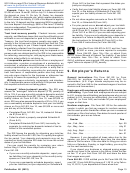 13
13 14
14 15
15 16
16 17
17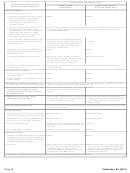 18
18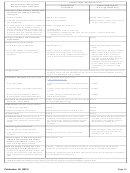 19
19 20
20 21
21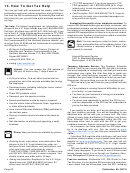 22
22 23
23 24
24 25
25